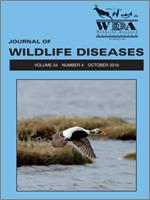Wild birds are natural hosts of avian influenza viruses (AIV) and can transmit viruses to poultry and other species. To monitor the prevalence of AIV antibodies, 211 eggs from wild Mallards (Anas platyrhynchos) and 177 from wild White-winged Terns (Chlidonias leucopterus) were collected from Zhalong Wetland and Xianghai Wetland in northeastern Republic of China from April to September, 2016. A hemagglutinin inhibition test detected the presence of H1, H3, H5, and H7 subtype-specific antibodies. The prevalences of AIV antibodies of subtypes H1 and H3 were relatively high while the prevalences of H5 and H7 AIV subtype antibody were low. In Zhalong Wetland, the prevalence of H1 AIV subtype antibody in Mallards was the highest, with a percentage of 11.0%. Prevalence of all AIV subtype-specific antibodies in Mallards was higher than those in White-winged Terns.
How to translate text using browser tools
1 October 2018
Prevalence of Multiple Subtypes of Avian Influenza Virus Antibodies in Egg Yolks of Mallards (Anas platyrhynchos) and White-winged Terns (Chlidonias leucopterus) in the Northeastern Republic of China
Xuelong Chen,
Yanping Qi,
Honghai Wang,
Yafei Wang,
Haixia Wang,
Hongbo Ni
ACCESS THE FULL ARTICLE

Journal of Wildlife Diseases
Vol. 54 • No. 4
October 2018
Vol. 54 • No. 4
October 2018
AIV antibody
avian influenza virus
HI test
mallards
White-winged Terns




